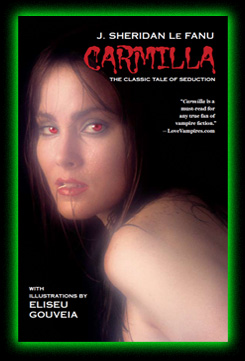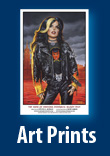 Just as the title suggests, today’s the day we begin celebrating the first publication of J. Sheridan Le Fanu’s trendsetting vampire tale, Carmilla, which debuted in serialized form in the pages of the magazine Dark Blue—running from the December 1871 issue through March 1872—then was reprinted in Le Fanu’s short story collection, In a Glass Darkly, which was published later that year. And what better time to mark the occasion than during this year’s Women in Horror celebration?
Just as the title suggests, today’s the day we begin celebrating the first publication of J. Sheridan Le Fanu’s trendsetting vampire tale, Carmilla, which debuted in serialized form in the pages of the magazine Dark Blue—running from the December 1871 issue through March 1872—then was reprinted in Le Fanu’s short story collection, In a Glass Darkly, which was published later that year. And what better time to mark the occasion than during this year’s Women in Horror celebration?
If you’re unfamiliar with what’s probably Le Fanu’s most famous work, here’s the back-cover copy from the edition that we published in 2010, which has become the most popular title in our Illustrated Classics line:
Before Edward and Bella, before Lestat and Louis, even before Dracula and Mina, there was the vampiric tale of Carmilla and Laura.
Living with her widowed father in a dreary old castle in the woods of Styria, Laura has longed to have a friend with whom she can confide; a friend to bring some excitement to her pastoral lifestyle. And then Carmilla enters her life.
Left by her mother in the care of Laura’s father, Carmilla is young, beautiful, playful—everything that Laura had hoped to find in a companion. In fact, the lonely girl is so thrilled to have a new friend that she is willing to overlook the dark-haired beauty’s strange actions…which include a disturbing, growing obsession for her lovely hostess.
Carmilla, it seems, desires more than just friendship from Laura….
What makes it a “trendsetting vampire tale,” you ask? Well, beyond acting as an inspiration for Bram Stoker in the creation of the vampire brides who threaten Jonathan Harker in Stoker’s seminal novel, Dracula, Carmilla is regarded by a good number of literary experts as being one of the first lesbian vampire stories. Beyond Le Fanu’s well-written prose, it’s that “scandalous” aspect that’s helped keep the tale of Carmilla and Laura in the public’s awareness, and which (naturally) has appealed to filmmakers for decades—Hammer Films’ The Vampire Lovers, director Roger Vadim’s Blood and Roses, and the comedy Lesbian Vampire Killers (starring talk-show host James Corden!) are prime examples of sex being the primary box-office appeal of Carmilla.
On a more literary note, critics continue to enjoy this tale:
“What makes Carmilla so endearing [is] the fact that the story is centered around two female characters, whose complicated relationship is colored by thinly veiled lesbian undertones.”—Slate
“Like many vampire romances, Carmilla and Laura’s love is doomed and unhealthy, but glorious.”—io9
“Carmilla manages to pack in a lot of creepiness, narrative complexity, and moral ambiguity. It is worth reading both as a progenitor of the vampire genre and as a nuanced portrayal of a female relationship—part romance, part horror story—that exists outside the confines of masculine power.” —The Toast
“With a cover that looks like it belongs on the paranormal romance shelf in a bookstore and half a dozen illustrations provided by Eliseu Gouveia, [the StarWarp Concepts] edition stands a good chance of tempting some younger readers to pick up this classic vampire tale…. I wish I’d picked this book up in seventh grade instead of slogging through Dracula.”—The Gothic Library
On Monday, we’ll begin looking at some adaptations of Carmilla, starting with a comic version that first appeared in the pages of Warren Publishing’s Creepy #19, from 1968. Come join us in celebrating Carmilla’s anniversary!
Carmilla—the SWC edition, featuring six original illustrations by artist Eliseu Gouveia (Lorelei: Sects and the City, A Princess of Mars)—is available in print and digital formats, so visit its product page for ordering information.






